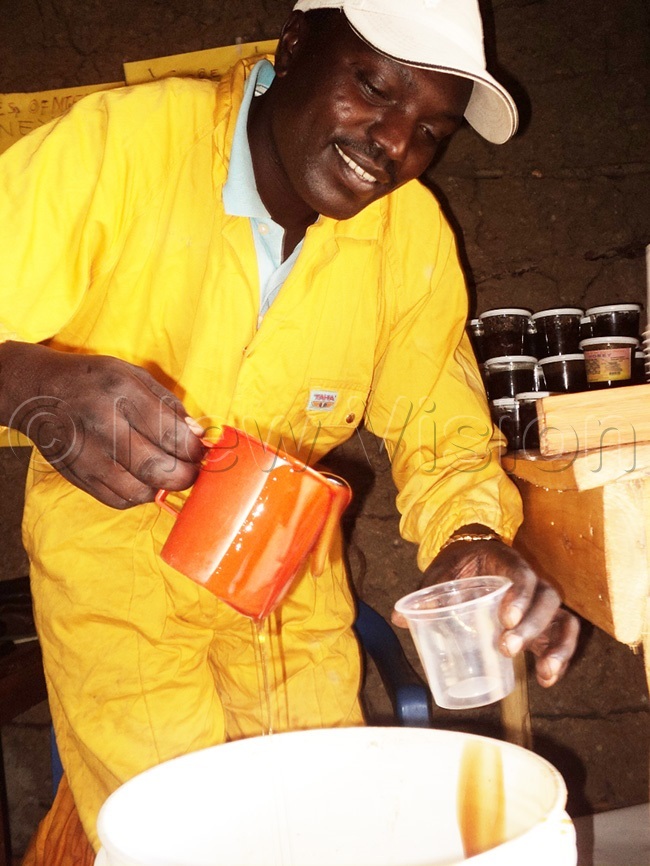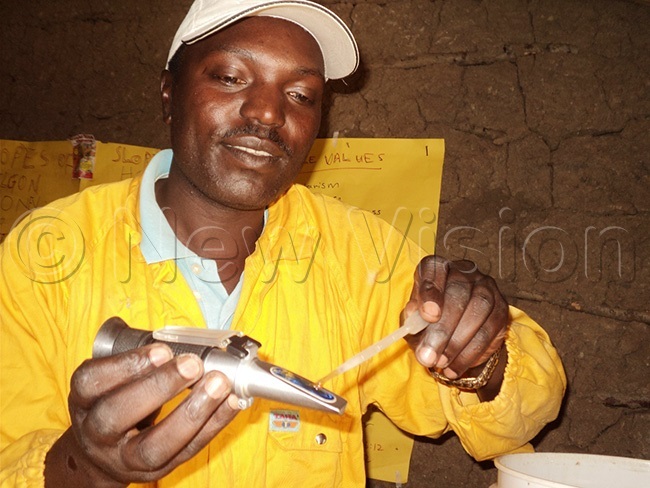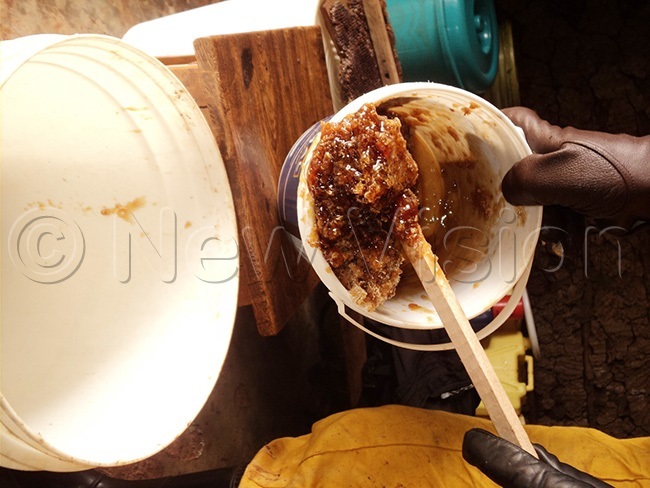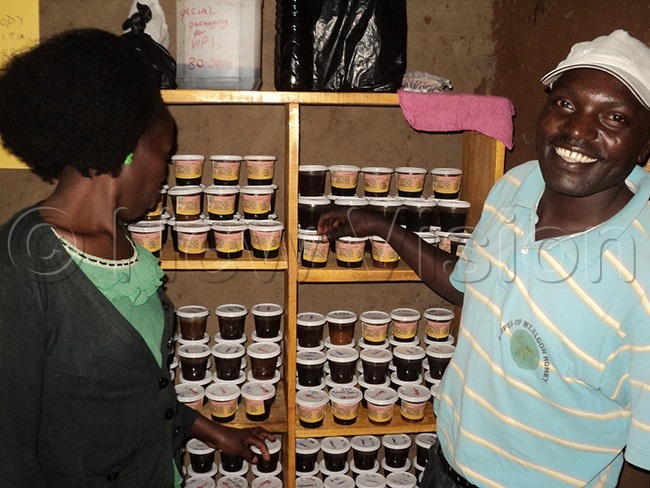Honey: The sweet enterprise that gave Kipmos a job
BEST FARMER :
When National Water and Sewerage Corporation (NWSC) headquarters Kampala could not recruit him as a plumber, in 2014, Abraham Kipmos resolved never to look for a job again.
Although he still had a paid-up month affront, for the apartment that would pass for a ghetto, in the slum areas of Bikere, in Kitintale, in Nakawa, he could not wait for his no no-sense landlord to come harassing him over rent for the subsequent months.
He picked his few possessions, retreated back to Kapchorwa with a dream of forging a way to create his own employment, through wild honey.
"I am happy to note that the almighty God has been on my side, what once was a dream has, in the end, turned into reality," says a delighted Kipmos.
From a humble beginning of sourcing for honey from the wilderness of Mt Elgon National Park, Kipmos is now an accomplished and a re-known honey supplier boasting of an elaborate value addition honey business that he says is worthy around sh88m.

The occupation of keeping bees, buying and processing honey that he neatly packages and brands under "Slopes of Mountain Elgon honey", at the moment, graces racks of supermarkets in Kapchorwa and Kampala, among other potential markets.
As if that is not enough, he is also earning from byproducts of honey.
"I'm making wine out the byproducts of honey which serve as a recipe of making a honey wine brew," he reveals with a beaming
smile.
Evaluation of the wine industry alone, in a season, Kipmos could make a turnover of sh80m.
Why Kapchorwa has honey
Kapchorwa, which is a fraction of the great Sebei (sabiny region) is endowed with the natural resources.
Among the resources is the mountainous terrain that puts it on a high altitude, which is a favorable environment for the bees.
Who is Kipmos
Born 33 years to Paul Musani and Riose Musani, residents of Kapchosombe, Kapchosombe sub-county in Kapachorwa district, Kipmos went to Tegeres Senior secondary school.
After form six, he enrolled at Royal Institute of Business Technical Studies in Bwaise, Kampala, obtaining a diploma certificate in plumbing.
Growing up in the village, his father would ask him to graze the family herd of cattle.
"We would take the herd in forest reserve to graze and it was during these tasks that I discovered wild honey in the forest," recalls Kipmos.
Together with his peers, they would harvest the wild honey that they would take home.
"We would sometimes trek 15km to Kapchorwa town where we would vend it and get pocket money, while the rest of the proceeds accrued from the sale would be surrendered to our parents," he recalls.
However, as years went by, they dropped the idea of honey business concentrating on their studies.
In 2009, he came to Kampala for the first time. A brief stint in Kampala while he was pursuing the course in plumbing had proven that there was a high demand for honey. He then decided to carry some from Kapchorwa.
"I would carry 10 litre jerrican of honey whenever I would be reporting back to school, and I would sell it whenever I was broke," he remembers.
Once he had gone to vend the honey and one of his clients advised him to think about packaging it.
"I used the little money that I had to purchase packing material and labeling, then supplied it to a nearby super market," Kipmos says.
When he finished his plumbing course, his dream was to get recruited as a plumber at National Water and Sewerage
Corporation (NWSC).
"But after several futile attempts to get recruited as a plumber at NWSC, I started focusing my attention to the honey business and I have never looked back," says Kipmos.

Keeping hives, sourcing honey from others
Kipmos has an apiary with a total of 48 hives that he set up in October 2015 in Kapchosombe.
The hives are modern KTB hives, each costing around sh100,000. Of these, 16 have already been colonized and he expects at least 160kgs of honey in the next few months.
"Colonisation has been a bit slow because I set them up during the wet season, however, when all of them are fully colonized, I expect to get at least 480kgs per harvest," he says.
Because his hives are not yet fully colonized, he relies on outsourcing honey from local suppliers.
Kipmos says to satisfy his demand for honey per annum, he buys 2000kg of unprocessed honey from the farmers.
He says he buys a Kg of honey at sh7,500. He, therefore, spends around sh16m per year on honey purchasing.
After processing, which includes distilling and diluting, he packs the honey in plastic containers. "I usually get 120 plastic containers (350ml) from every 20 litres of honey," he explains. He then disposes each of the 350ml pure honey pack at sh8,000. This gives him at least sh960,000 as gross.
Earnings and expenses
If each 350ml pack of pure honey goes for sh8,000.This multiplied by 120 bottles equals sh960,000. He buys each of the 350ml plastic containers at sh1,000 plus the label sh200.
This means that the packaging costs incurred on each bottle is sh1200 or sh144,000 for the 120 bottles.
Since he bought the crude honey at sh75,000, plus the expenses on packaging this leaves him with around sh741,000 as profit from 20litres of honey.
He says that he processes around 2,000 litres of honey per year.
Kipmos employs three workers. "I now have two branches in Kapchorwa, so I employ two people to run one branch, while I run the second branch with another worker," he says.
He pays them a total of sh300,000 per month or sh3.6m per year.
He says he makes a profit of around sh20m per year.
How he processes honey
Honey like any other foodstuff entails an elaborate ritual.
Kipmos, who has since gone through numerous training in honey processing and handling has to thoroughly scrutinize the process lest he compromises his standards before his trusting clientele.
"I scrutinize honey that I'm about to buy using a device called a handheld refractometer. The purpose of this device is to a certain whether the honey meets the standard measurement of moisture content that must be 20 degrees," he explains.
The device that offers instant results is fed with samples of unprocessed honey that is obtained using a burrette.
With the lens pointed in the blue sky, the user would be compelled to cringe his/her eye though the lens-hole to read what would be reflect on its interior scale reading mark.
In the event that the farmer has tempered with honey, the reading scale will reflect accordingly, rendering the potential buyer to take the due decision of dumping the transaction.
In the circumstance that the honey meets the required standards, Kipmos, usually clears the farmer right away, stashes the honey in an airtight pail, and retreats back at his work station.
Once at the work station, he is compelled to softly but repeatedly poke into the honey that is usually lased with comb crumbs.
"When the huge comb crumbs are broken into small crumbs I'm obliged to cover up the air-tight-pail wait for three hours to allow the thick paste to settle," explains Kipmos.
When the three hours lapses, Kipmos is obliged to bring yet another empty clean pain, cover it with a huge sieve, before beginning the sieving process that takes another three hours.
After sieving exercise, honey is ready for packing.
Kipmos who is just an upcoming entrepreneur has not yet acquired the sophisticated packing machine.
"I manually fix the label and pack honey in the empty plastic containers of 350ml," he explains.
The few years in business have enlightened him on tastes and preferences of the clients.
"A section of customers prefer sieved honey, while others prefer itwhen it still holds comb crumbs, and as I pack I have to consider
these basic realities," he observes.

Processing wine
Until the senior generation of this community discovered the intrinsic value embedded in the byproducts of honey, honey processors would discard.
According to Kipmos, honey byproducts obtained from a kg of honey can be adequate enough to serve as ingredients for a 20 litre jerrican of wine.
After the honey has been extracted, the byproducts among them combs and other honey impurities are stashed in a clean air-tight-pail or drum.
To brew wine, one is required to pour a jerrican of clean, safe in the sticky and pasty stuff (byproduct).
"The other recipe added in the solution is a special wild plantain, whose main function is not only to catalyze the solution during fermentation but also give the brew a tasty aroma," explains kipmos.
Whoever is making the brew is obliged to steer in the solution for sometimes, before securely covering the airtight container.
"Wine will be ready for consumption after three days," says Kipmos.
A 20litre jerrican of wine goes for sh80,000.

Achievements
Three years in the honey business, Kipmos has been able to buy a piece of land at shs10millions within Kapchorwa municipality.
Out of the proceeds from the business, he has been able to embark on the construction of a four-bedroom house that is still at a foundation level.
He also has been able to buy a motorcycle at shs4m.
"Acquiring a motorcycle has not only cut down my transport expenses but its availability has inevitably fastened my movements in the course of doing business of the day," explains Kipmos.
His future plan is to establish a vocation institute that could mentor
learners in the beekeeping industry and the art of making apiaries.
What others say
Karura Charles,48, an elder, and enthusiast agronomist is delighted with the positive strides Kipmos has taken.
"He is one promising young man who if supported, he is capable of becoming an enviable entrepreneur," he observes.
His earnest appeal to relevant authorities in government is to consider the resourcefulness of young stars like Kipmos.
"Kapchorwa like the rest of the areas constituting Sebei has a virgin economic sector that government has never attempted explore," he observes with concern.
His argument is for the government to utilize the likes of Kipmos to train scores of youth wasting themselves away.
"If this sector is fully funded and allotted with a team of experts, Sebei region alone has the capacity of producing 50 tonnes of honey in a season," stresses Karura.
Martin Sekuton, who is also Farmer's Development Association Coordinator, says the success of Kipmos ought to provoke relevant authorities in government to begin looking for a foreign market for honey.